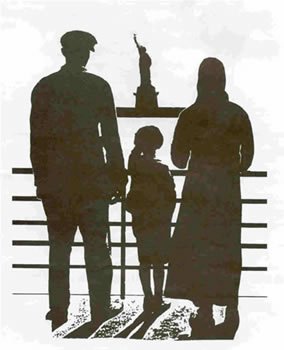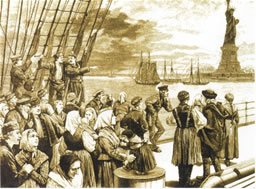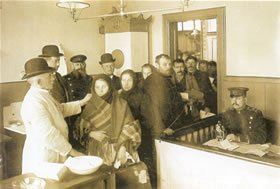Arrival in the USA
Points of immigration - Castle Garden and Ellis Island
"...In 58 days we finally arrived happily to New York, being tired from crossing the ocean. After two days of relaxation we set out for a journey to Bufallo, that has been just a small town that time. From there we continued on the journey to Detroit that has been also very poor yet. From Detroit we approached to Chicago, which could have been bougt easily by any richer immigrant that days. There was only one pub, looking more like a border log cabin than any dinner house. It composed just from one room, waiting hall and a dinning room...".

When asking descendants, most people know, for example, that their family "left the Old Land around the year.... and then settled and now is still living in ....". When asking further, mostly there is a gap between the estimated arrival in America and the final place of settlement. Most people do not know how their ancestors came from the point of disembarking to their final settlement.
The majority of the immigrants entered the USA through New York, Baltimore, or Boston on the East Coast, or through Galveston in Texas. Some also came directly through the Saint Lawrence Seaway into the harbors around the Great Lakes.


Arrival (© 2) and check-in in New York (© 2)
Upon arrival in New York, most Czech immigrants arriving between 1855 and 1890 entered the country through the immigration facilities in Castle Garden. At that time -still an artifical island just off Manhattan Island- it was America's first immigration center. Castle Garden closed in April 1890, and for a brief interlude, Barge Office in Manhattan was the immigration facility. Ellis Island opened as an immigration facility in 1892, to handle the floodwave of immigrants. Its peak year was 1907, with over a million immigrants arriving that year. However, by the time Ellis Island was opened, most Czechs who helped settle the prairie states had already arrived.
After their arrival, some immigrants stayed in the larger cities and tried to earn some more money first. Others continued westward directly upon arrival, following invitations of earlier settlers or just trying to get land as quick as possible.
Many Czechs claimed land under the Homestead Act or bought railroad land in the newly established Midwest States. In the last decades of the 19th century, settled Czechs helped newcomers to find and settle land in the new States.
Several Czechs from the Kojakovice - Hrdlorezy region in Southeast Bohemia arrived in Chicago and, through the help of such committees, continued their journey westward by train, arriving in Wilson, Kansas, in 1876. Frank Swehla, an earlier settler who was strongly involved in organizing settler groups and helping new arrivals, took them on a wagon out of Wilson station and drove them southward to view the available claims.
One by one, they jumped off the wagon and made their choice. They had arrived at their new homeland; many of their descendants still live there.
Unless mentioned differently, all pictures are © collection Rozmberk Society, Friends of the Rozmberk Society, or provided under © by individual partners. In some instances, copyright is public domain or could not be established or obtained within reasonable effort.
2) Courtesy Staatsarchiv Hamburg
4) Courtesy Ulster American Folkpark
Design by the Bear (Robert Dulfer 2006-2016)


